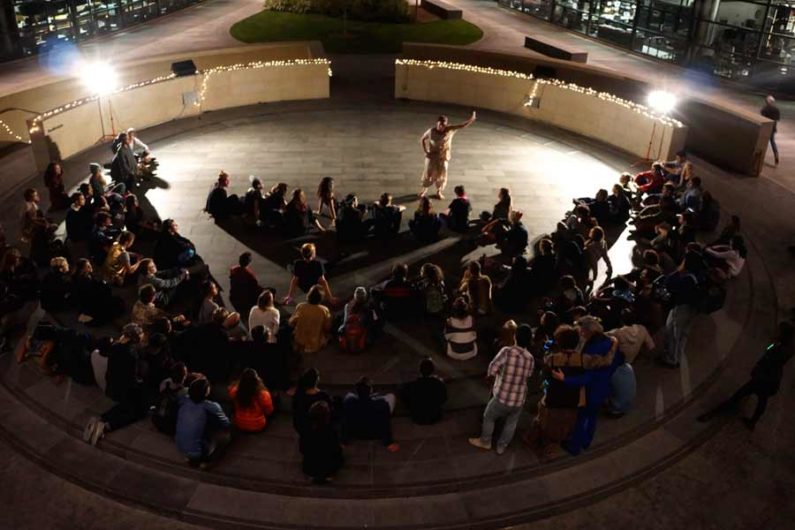Stanford Honors in the Arts capstone program evolves with a new Mellon grant
A new grant will support Stanford Arts Institute’s development of an interdisciplinary undergraduate program in the arts.
Stanford University has been awarded an Andrew W. Mellon Foundation grant to support the development of a new undergraduate, interdisciplinary program in the arts to be administered by Stanford Arts Institute.

Honors in the Arts students present Bacchae, an immersive theatrical experience utilizing locations across the Stanford campus. (Image credit: Kristen Stipanov)
The $400,000 grant provides support for integrating the successful Mellon Interdisciplinary Honors in the Arts (HIA) capstone program into a new, four-year program dedicated to interdisciplinary and intermedia art education. HIA began as a pilot program in 2013 funded by the Mellon Foundation.
The new grant will provide funding for four years.
“The Honors in the Arts program has been a powerful catalyst for Stanford students to develop projects that bring their artistic expression into sustained contact with another discipline,” said MATTHEW TIEWS, associate vice president for the arts at Stanford. “It has been a marvelous outcome of Stanford’s collaborative ethos and its commitment to building new arts programs. This award will allow the program to evolve to the next level, and we are excited to see how it will develop.”
Under the leadership of PEGGY PHELAN, faculty director and principal investigator, Stanford Arts Institute will organize a faculty working group in the 2017-18 academic year to best assess how the new program will strengthen and complement current academic offerings. The group will also consider, among other possibilities, creating a minor, a concentration or a major.
HIA offers seniors the opportunity to combine their creative and critical imaginations to produce a project that explores a central disciplinary question from an artistic point of view. The results have been impressive: a published novel, a prize-winning film, two books of poetry that are seeking publishers and enormous intellectual and artistic growth for students.
The addition of HIA is one of numerous efforts Stanford has implemented to increase undergraduate opportunities in the arts, including:
- ITALIC, the residence-based academic program for first-year students
- Stanford in New York, a quarter-long, immersive experience often pursued by students in their third or fourth year
- Arts Immersion, weeklong arts engagement experiences around the country
- Excursions connected to quarter-length courses that allow students to attend remarkable performances, such as the San Francisco tour of Hamilton
- Art Intensive, allowing students opportunities to work with guest artists during Stanford’s Sophomore College
Stanford has also created more spaces for students to train and perform, including:
- Roble Studio Theater and the Arts Gym – both in the newly renovated Roble Gymnasium, home to the Department of Theater and Performance Studies
- Three new student exhibition spaces in the McMurtry Building for the Department of Art and Art History
- Nitery Theater, an 83-seat black box theater that has been rededicated to be the first student-run theater space on campus
- Meyer Green, the outdoor landscaped bowl which also serves as an open-space staging area
Given the rising number of students interested in art and the enhanced quality of such work, Phelan proposed that the Mellon Foundation help transition the HIA capstone program into a four-year program.
“The success of the HIA program has inspired us to increase opportunities for students to do interdisciplinary art work over their four-year experience here. We hope the new program will offer many entrance ramps for students who want to experiment with collaboration, creative thinking and critical theory about a range of art,” Phelan said.
She added, “All of these programs attract great student interest and strong applicant pools because undergraduates rightly see these encounters with art as central to the thinking they are doing in their majors. Stanford Arts Institute will build upon these programs to combine the work students are already doing into a more coherent four-year program in the arts. The new program will focus on giving students tools to become adept at collaboration and foster team-based projects, especially in the capstone year.”
